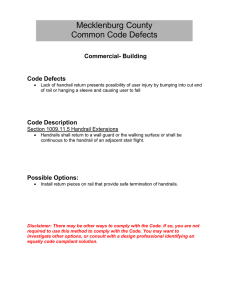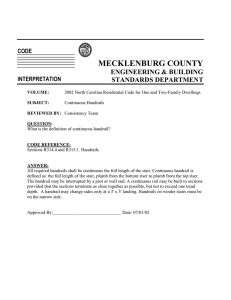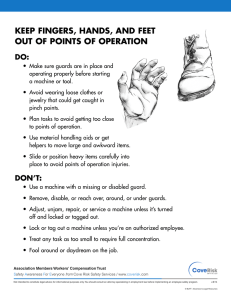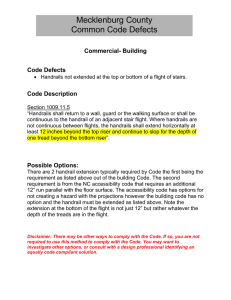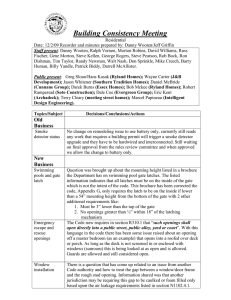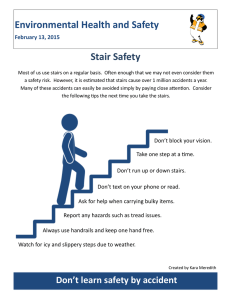Handrails and Guards
advertisement
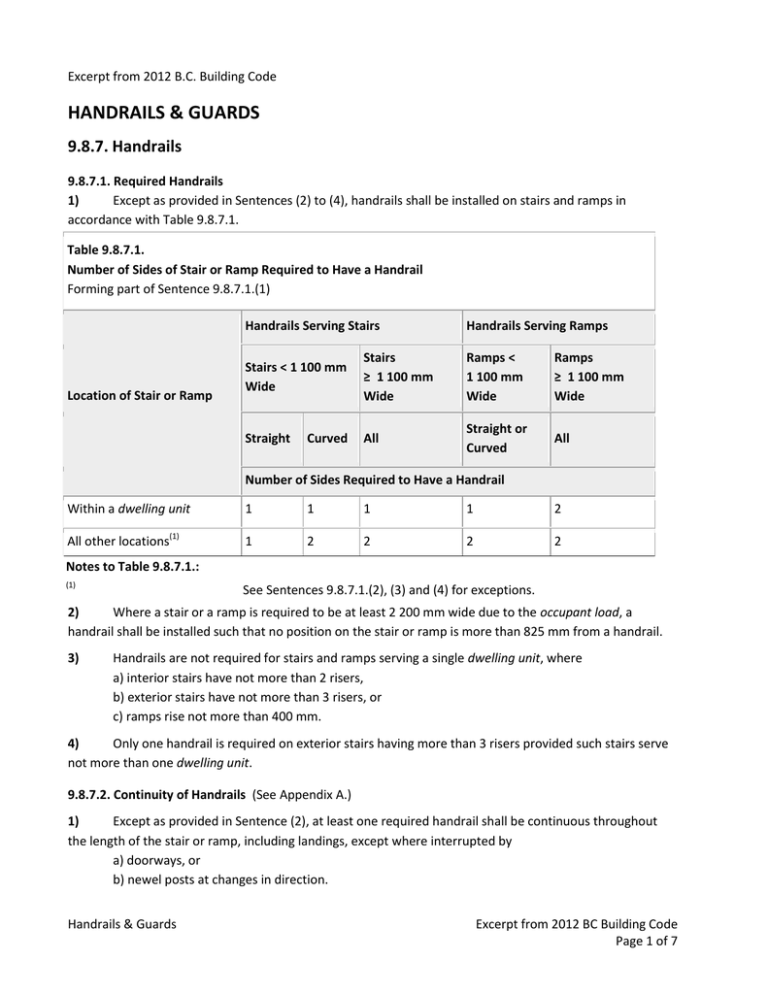
Excerpt from 2012 B.C. Building Code HANDRAILS & GUARDS 9.8.7. Handrails 9.8.7.1. Required Handrails 1) Except as provided in Sentences (2) to (4), handrails shall be installed on stairs and ramps in accordance with Table 9.8.7.1. Table 9.8.7.1. Number of Sides of Stair or Ramp Required to Have a Handrail Forming part of Sentence 9.8.7.1.(1) Handrails Serving Stairs Location of Stair or Ramp Handrails Serving Ramps Stairs < 1 100 mm Wide Stairs ≥ 1 100 mm Wide Ramps < 1 100 mm Wide Ramps ≥ 1 100 mm Wide Straight All Straight or Curved All Curved Number of Sides Required to Have a Handrail Within a dwelling unit 1 1 1 1 2 All other locations(1) 1 2 2 2 2 Notes to Table 9.8.7.1.: (1) See Sentences 9.8.7.1.(2), (3) and (4) for exceptions. 2) Where a stair or a ramp is required to be at least 2 200 mm wide due to the occupant load, a handrail shall be installed such that no position on the stair or ramp is more than 825 mm from a handrail. 3) Handrails are not required for stairs and ramps serving a single dwelling unit, where a) interior stairs have not more than 2 risers, b) exterior stairs have not more than 3 risers, or c) ramps rise not more than 400 mm. 4) Only one handrail is required on exterior stairs having more than 3 risers provided such stairs serve not more than one dwelling unit. 9.8.7.2. Continuity of Handrails (See Appendix A.) 1) Except as provided in Sentence (2), at least one required handrail shall be continuous throughout the length of the stair or ramp, including landings, except where interrupted by a) doorways, or b) newel posts at changes in direction. Handrails & Guards Excerpt from 2012 BC Building Code Page 1 of 7 2) For stairs or ramps serving a single dwelling unit at least one required handrail shall be continuous throughout the length of the stair or ramp, except where interrupted by a) doorways, b) landings, or c) newel posts at changes in direction. 9.8.7.3. Termination of Handrails 1) Handrails shall be terminated in a manner that will not obstruct pedestrian travel or create a hazard. (See Appendix A.) 2) Except for stairs and ramps serving only one dwelling unit at least one handrail at the sides of a stair or ramp shall extend horizontally not less than 300 mm beyond the top and bottom of each flight or ramp. (See Appendix A.) 9.8.7.4. Height of Handrails (See Appendix A.) 1) to 2) The height of handrails on stairs and ramps shall be measured vertically from the top of the handrail a) a straight line drawn tangent to the tread nosings of the stair served by the handrail, or b) the surface of the ramp, floor or landing served by the handrail. Except as provided in Sentences (3) and (4), the height of handrails on stairs and ramps shall be a) not less than 865 mm, and b) not more than 965 mm. 3) Where guards are required, handrails required on landings shall be not more than 1 070 mm in height. 4) Handrails installed in addition to required handrails need not comply with Sentence (2). 9.8.7.5. Ergonomic Design 1) A clearance of not less than 50 mm shall be provided between a handrail and any surface behind it. 2) All handrails shall be constructed so as to be continually graspable along their entire length with no obstruction on or above them to break a handhold, except where the handrail is interrupted by newels at changes in direction. (See Appendix A.) 9.8.7.6. Projections into Stairs and Ramps 1) Handrails and constructions below handrails, including handrail supports and stair stringers, shall not project more than 100 mm into the required width of a stair or ramp. (See also Articles 9.8.2.1. and 9.8.5.2.) Handrails & Guards Excerpt from 2012 BC Building Code Page 2 of 7 9.8.7.7. Design and Attachment of Handrails (See Appendix A.) 1) Handrails and any building element that could be used as a handrail shall be designed and attached in such a manner as to resist a) a concentrated load at any point of not less than 0.9 kN, and b) for handrails other than those serving a single dwelling unit, a uniformly distributed load of 0.7 kN/m. 2) Where a handrail serving a single dwelling unit is attached to wood studs or blocking, the attachment shall be deemed to comply with Sentence (1) where a) the attachment points are spaced not more than 1.2 m apart, b) the first attachment point at either end is located no more than 300 mm from the end of the handrail, and c) the fasteners consist of not less than 2 wood screws at each point, penetrating not less than 32 mm into solid wood. 9.8.8. Guards 9.8.8.1. Required Guards (See Appendix A.) 1) Except as provided in Sentences (2) and (3), every surface to which access is provided for other than maintenance purposes, including but not limited to flights of steps and ramps, exterior landings, porches, balconies, mezzanines, galleries and raised walkways, shall be protected by a guard on each side that is not protected by a wall for the length where a) there is a difference in elevation of more than 600 mm between the walking surface and the adjacent surface, or b) the adjacent surface within 1.2 m of the walking surface has a slope of more than 1 in 2. 2) Guards are not required a) at loading docks, b) at floor pits in repair garages, or c) where access is provided for maintenance purposes only. 3) Where an interior stair has more than 2 risers or an interior ramp rises more than 400 mm, the sides of the stair or ramp and the landing or floor level around the stairwell or ramp shall be protected by a guard on each side that is not protected by a wall. 4) Doors in buildings of residential occupancy, where the finished floor on one side of the door is more than 600 mm above the floor or other constructed surface or ground level on the other side of the door, shall be protected by a) a guard, or b) a mechanism capable of controlling the free swinging or sliding of the door so as to limit any clear unobstructed opening to not more than 100 mm. Handrails & Guards Excerpt from 2012 BC Building Code Page 3 of 7 5) Except as provided in Sentence (6), openable windows in buildings of residential occupancy shall be protected by a) a guard, or b) a mechanism capable of controlling the free swinging or sliding of the openable part of the window so as to limit any clear unobstructed opening to not more than 100 mm measured either vertically or horizontally where the other dimension is greater than 380 mm. (See Appendix A.) 6) Windows need not be protected in accordance with Sentence (5), where a) the window serves a dwelling unit that is not located above another suite, b) Reserved. c) the only opening greater than 100 mm by 380 mm is a horizontal opening at the top of the window, d) the window sill is located more than 450 mm above the finished floor on one side of the window, or e) the window is located in a room or space with the finished floor described in Clause 9.8.8.1.(6)(d) located less than 1 800 mm above the floor or ground on the other side of the window. (See A-9.8.8.1.(5) in Appendix A.) 7) Except as provided in Sentence (8), glazing installed over stairs, ramps and landings that extends to less than 1 070 mm above the surface of the treads, ramp or landing shall be a) protected by guards, in accordance with this Subsection, or b) non-openable and designed to withstand the specified lateral loads for balcony guards as provided in Article 4.1.5.14. 8) In dwelling units, glazing installed over stairs, ramps and landings that extends to less than 900 mm above the surface of the treads, ramp or landing shall be a) protected by guards, in accordance with this Subsection, or b) non-openable and designed to withstand the specified lateral loads for balcony guards as provided in Article 4.1.5.14. 9) Glazing installed in public areas that extends to less than 1 m from the floor and is located above the second storey in buildings of residential occupancy shall be a) protected by guards in accordance with this Subsection, or b) non-openable and designed to withstand the specified lateral loads for balcony guards as provided in Article 4.1.5.14. Handrails & Guards Excerpt from 2012 BC Building Code Page 4 of 7 9.8.8.2. Loads on Guards (See Appendix A.) 1) Guards shall be designed to resist the specified loads prescribed in Table 9.8.8.2. Table 9.8.8.2. Specified Loads for Guards Forming part of Sentence 9.8.8.2.(1) Minimum Design Loads Horizontal Load Applied Inward or Outward at any Point at the Minimum Required Height of the Guard Horizontal Load Applied Inward or Outward on Elements Within the Guard, Including Solid Panels and Pickets Guards within dwelling units and exterior guards serving not more than 2 dwelling units 0.5 kN/m OR concentrated load of 1.0 kN applied at any (1) point 0.5 kN applied over a maximum 1.5 kN/m width of 300 mm and a height (2) of 300 mm Guards serving access walkways to equipment platforms, contiguous stairs and similar areas Concentrated load of 1.0 kN applied at any point Concentrated load of 0.5 kN applied at any point on individual elements 1.5 kN/m All other guards 0.75 kN/m OR concentrated load of 1.0 kN applied at any (1) point Concentrated load of 0.5 kN applied at any point on individual elements 1.5 kN/m Location of Guard Evenly Distributed Vertical Load Applied at the Top of the Guard Notes to Table 9.8.8.2.: (1) The load that creates the most critical condition shall apply. (2) See Sentence (2). 2) Where the width and spacing of balusters in guards within dwelling units and in exterior guards serving not more than 2 dwelling units is such that 3 balusters can be engaged by a load imposed over a 300 mm width, the load shall be imposed so as to engage 3 balusters. 3) None of the loads specified in Table 9.8.8.2. need be considered to act simultaneously. 4) For guards within dwelling units and for exterior guards serving not more than 2 dwelling units, Table 9.8.8.2. need not apply where the guard construction used has been demonstrated to provide effective performance. Handrails & Guards Excerpt from 2012 BC Building Code Page 5 of 7 9.8.8.3. Height of Guards (See Appendix A.) 1) Except as provided in Sentences (2) to (4), all guards shall be not less than 1 070 mm high. 2) All guards within dwelling units shall be not less than 900 mm high. 3) Exterior guards serving not more than one dwelling unit shall be not less than 900 mm high where the walking surface served by the guard is not more than 1 800 mm above the finished ground level. 4) Guards for flights of steps, except in required exit stairs, shall be not less than 900 mm high. 5) The height of guards for flights of steps shall be measured vertically from the top of the guard to a line drawn through the leading edge of the treads served by the guard. 9.8.8.4. Guards for Floors and Ramps in Garages 1) Except for floors of garages referred to in Section 9.35., where garage floors or ramps are 600 mm or more above the adjacent ground or floor level, every opening through a garage floor and the perimeter of floors and ramps that have no exterior walls shall be provided with a) a continuous curb not less than 150 mm in height, and b) a guard not less than 1 070 mm above the floor level. 2) Vehicle guardrails shall be designed for a concentrated horizontal load of 22 kN applied outward at any point 500 mm above the floor surface. (See A-4.1.5.14. and 4.1.5.15.(1) in Appendix A.) 9.8.8.5. Openings in Guards 1) Except as provided in Sentence (2), openings through any guard that is required by Article 9.8.8.1. shall be of a size that will prevent the passage of a spherical object having a diameter of 100 mm unless it can be shown that the location and size of openings that exceed this limit do not represent a hazard. (See A9.8.8.5.(1) and (2) in Appendix A.) 2) Openings through any guard that is required by Article 9.8.8.1. and that is installed in a building of industrial occupancy shall be of a size that will prevent the passage of a spherical object having a diameter of 200 mm unless it can be shown that the location and size of openings that exceed this limit do not represent a hazard. (See A-9.8.8.5.(1) and (2) in Appendix A.) 3) Unless it can be shown that the location and size of openings that do not comply with the following limits do not represent a hazard, openings through any guard that is not required by Article 9.8.8.1. and that serves a building of other than industrial occupancy, shall be of a size that: a) will prevent the passage of a spherical object having a diameter of 100 mm, or b) will permit the passage of a spherical object having a diameter of 200 mm. (See Appendix A.) Handrails & Guards Excerpt from 2012 BC Building Code Page 6 of 7 9.8.8.6. Design of Guards to Not Facilitate Climbing 1) Guards required by Article 9.8.8.1., except those in industrial occupancies and where it can be shown that the location and size of openings do not present a hazard, shall be designed so that no member, attachment or opening facilitates climbing. 2) Guards shall be deemed to comply with Sentence (1) where all elements protruding from the vertical and located within the area between 140 mm and 900 mm above the floor or walking surface protected by the guard conform to at least one of the following Clauses: a) they are located more than 450 mm horizontally and vertically from each other, b) they provide not more than 15 mm horizontal offset, c) they do not provide a toe-space more than 45 mm horizontally and 20 mm vertically, or d) they present more than a 2-in-1 slope on the offset. (See Appendix A.) 9.8.8.7. Glass in Guards 1) Glass in guards shall be a) safety glass of the laminated or tempered type conforming to CAN/CGSB-12.1-M, “Tempered or Laminated Safety Glass,” or b) wired glass conforming to CAN/CGSB-12.11-M, “Wired Safety Glass.” Handrails & Guards Excerpt from 2012 BC Building Code Page 7 of 7
